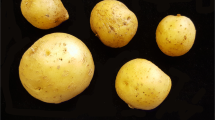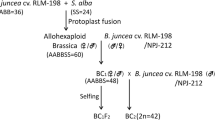Abstract
Potato has about 100 related wild Solanum species growing naturally in the Americas. Solanum jamesii (jam), native to the southwest USA and Mexico, has many valuable traits for breeding, but making hybrids is extremely difficult. We investigated the approach of using the bridge species Solanum verrucosum (ver). A survey of all ver populations in the US Potato Genebank identified the best females. The standard bridge crossing technique using emasculation of ver and “mentor” double pollination after first pollinating with jam was very inefficient for most ver because: 1) emasculation depressed seedset in ver females, 2) despite very careful emasculation many accidental ver selfs resulted, and 3) mentor pollination produced many unwanted hybrids with the mentor pollen parent. We therefore produced populations of ver by backcrossing five generations into tuberosum cytoplasm. The BC5 lines are very vigorous in growth and flowering, but having very low male fertility and complete self-incompatibility they can be mass crossed with jam pollen without emasculation. Even with no mentor pollen, most pistils of verBC5 pollinated with jam produce a small fruit with an average of less than one normal seed. Resulting seedlings were confirmed ver-jam hybrids by DNA markers.
Resumen
La papa tiene cerca de 100 especies silvestres de Solanum relacionadas que crecen de forma natural en las Américas. Solanum jamesii (jam) es nativa del suroeste de EUA y México, tiene muchas caracteristicas importantes para mejoramiento, sin embargo generar híbridos es extremadamente difícil. Nosotros investigamos la estrategia de usar Solanum verrucosum (ver) como especie puente. Una evaluación de todas las poblaciones de ver en el Banco de Germoplasma de Papa de EUA identificó a las mejores plantas maternas. La técnica estándar de hacer un cruzamiento puente mediante la emasculación de ver y la doble polinización del “mentor” después de la primera polinización con jam fue muy ineficiente para la mayoría de ver debido a: 1) la emasculación debilitó producción de semillas en plantas maternas de ver, 2) a pesar de una emasculación muy cuidadosa, muchas ver fueron accidentalmente autofecundadas, y 3) la polinización del mentor produjo muchos híbridos no deseados con el polen del mentor parental. Por ello nosotros producimos poblaciones de ver mediante retrocruza de cinco generaciones en citoplásma de tuberosum. Las líneas BC5 son muy vigorosas en crecimiento y floración, pero debido a que tienen muy baja fertilidad masculina y completa autoincompatibilidad, pueden cruzarse masivamente con el polen de jam sin emasculación. Aun sin polen del mentor, la mayoría de los pistilos de verBC5 polinizados con jam producen un fruto pequeño con un promedio de menos de una semilla normal. Las plántulas resultantes se confirmaron como híbridos ver-jam mediante marcadores de ADN.


Similar content being viewed by others
Abbreviations
- USPG:
-
US Potato Genebank;
- GRIN:
-
Germplasm Resources Information Network (https://npgsweb.ars-grin.gov/gringlobal/search)
References
Anisimova, I.N., and T.A. Gavrilenko. 2017. Cytoplasmic male sterility and prospects for its utilization in potato breeding, genetic studies and hybrid seed production. Russian Journal of Genetics: Applied Research 7: 721–735.
Bamberg, J., and A. del Rio. 2020. Assessing under-estimation of genetic diversity within wild potato (Solanum) species populations. American Journal of Potato Research 97: 547–553.
Bamberg, J., K. Lombard, J.P. Palta, B.A. Workmaster, and A. Atucha. 2020. Survival of Solanum jamesii tubers at freezing temperatures. American Journal of Potato Research 97: 497–504.
Bamberg, J.B. 2020. Emasculation technique reduces seedset in Solanum verrucosum. American Journal of Potato Research 97: 111–113.
Bamberg, J.B., and A. del Rio. 2008. Proximity and introgression of other potato species does not explain genetic dissimilarity between Solanum verrucosum populations of northern and southern Mexico. American Journal of Potato Research 85: 232–238.
Bamberg, J.B., A. del Rio, and C.J. Fernandez. 2017. Solanum jamesii—New traits and hybrids. American Journal of Potato Research 94: 211.
Bamberg, J.B., A. del Rio, J. Coombs, and D. Douches. 2015. Assessing SNPs versus RAPDs for predicting heterogeneity in wild potato species. American Journal of Potato Research 92: 276–283.
Bamberg, J.B., A.H. del Rio, D. Kinder, L. Louderback, B. Pavlik, and C. Fernandez. 2016. Core collections of potato (Solanum) species native to the USA. American Journal of Potato Research 93: 564–571.
Dionne, L. 1961. Mechanisms of interspecific incompatibility in tuber-bearing Solanum species. American Potato Journal 38: 73–77.
Gabriel, J.I., Ruiz de Galarreta, R. Lopez-Pardo, L. Barandalla, C. Alvarado, and E. Ritter. 2011. Short communication. Introgression of late blight (Phytophthora infestans L.) resistance from tuber-bearing Solanum wild species into cultivated potato. Spanish Journal of Agricultural Research 9: 193–197.
Helgeson, J.P., J.D. Pohlman, S. Austin, G.T. Haberlach, S.M. Wielgus, D. Ronis, L. Zambolin, P. Tooley, J.M. McGrath, R.V. James, and W.R. Stevenson. 1998. Somatic hybrids between Solanum bulbocastanum and potato: A new source of resistance to late blight. Theoretical and Applied Genetics 96: 738–742.
Hermsen, J.G.Th, and J. Verdenius. 1973. Selection from Solanum tuberosum group Phureja of genotypes combining high frequency haploid induction with homozygosity for embryo-spot. Euphytica 22: 244–259.
Johnston, S.A., and R.E. Hanneman Jr. 1980. Support of the endosperm balance number hypothesis utilizing some tuber-bearing Solanum species. American Potato Journal 57: 7–14.
Livermore, J.R., and F.E. Johnstone. 1940. The effect of chromosome doubling on the crossability of Solanum chacoense, S. jamesii, and S. bulbocastanum with S. tuberosum. American Potato Journal 17: 170–173.
Novy, R.G., and R.E. Hanneman Jr. 1991. Hybridization between Gp. Tuberosum haploids and 1EBN wild potato species. American Potato Journal 68: 151–169.
Ordoñez, B., M. Orrillo, and M. Bonierbale. 2017. Manual on potato reproductive and cytological biology. Lima (Peru). International Potato Center (CIP). ISBN 978-92-9060-480-8. 65 pp.
Sanetomo, R., S. Akino, N. Suzuki, and K. Hosaka. 2014. Breakdown of a hybridization barrier between Solanum pinnatisectum Dunal and potato using the S locus inhibitor gene (Sli). Euphytica 197: 119–132.
Williams, P.H. 1980. Bee-sticks, an aid in pollinating Cruciferae. HortScience 15: 802–803.
Yermishin, A.P., V. Polyukhovich, E.V. Voronkova, and A.V. Savchuk. 2014. Production of hybrids between the 2EBN bridge species Solanum verrucosum and 1EBN diploid potato species. American Journal of Potato Research 91: 610–617.
Acknowledgments
We thank Mrs. Renee Sauer for help in making crosses and recording data, as well as the University of Wisconsin Peninsular Agricultural Research Station program and staff for their cooperation. The US Potato Genebank, like most other genebanks, keeps stocks that have all combinations of potential usefulness and accessibility. The extreme potential usefulness of S. jamesii made increasing its current low accessibility through improved crossing techniques an attractive target.
Author information
Authors and Affiliations
Corresponding author
Supplementary Information
ESM 1
(DOCX 24 kb)
Rights and permissions
About this article
Cite this article
Bamberg, J., Kielar, A., del Rio, A. et al. Making Hybrids with the Wild Potato Solanum jamesii. Am. J. Potato Res. 98, 187–193 (2021). https://doi.org/10.1007/s12230-021-09828-1
Accepted:
Published:
Issue Date:
DOI: https://doi.org/10.1007/s12230-021-09828-1




